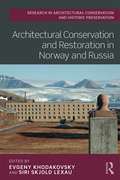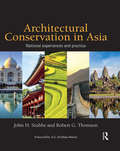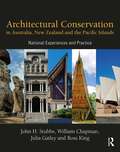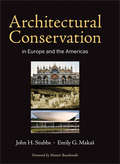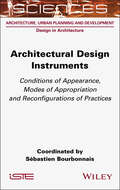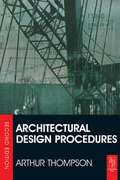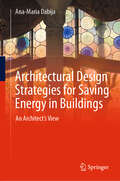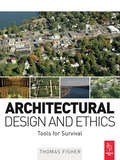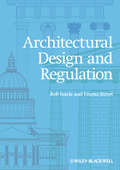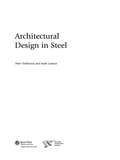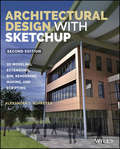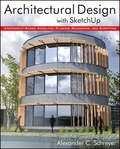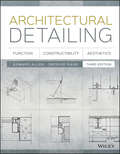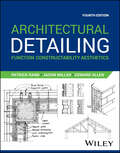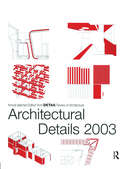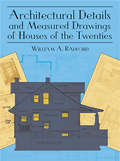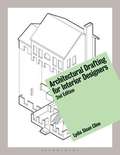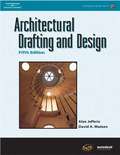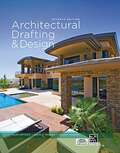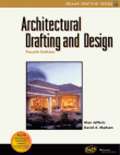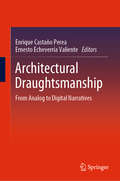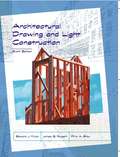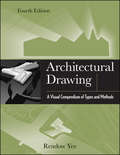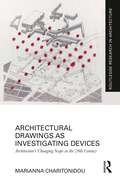- Table View
- List View
Architectural Conservation and Restoration in Norway and Russia (Routledge Research in Architectural Conservation and Historic Preservation)
by Evgeny Khodakovsky Siri Skjold LexauNorway and Russia have been closely related through the ages, both geographically and historically, and have experienced similar problems relating to climate, building maintenance and national wooden architecture. As a result, the parallel study of architectural conservation and restoration theories and practices in both neighbouring Northern states makes for a stimulating collective monograph. Architectural Conservation and Restoration in Norway and Russia delves into the main challenges of historic and contemporary architectural preservation practices in the two countries. The book consists of three main parts: the discovery and preservation of historical architecture in the late nineteenth to early twentieth century; contemporary approaches to former restorations and the conservation and maintenance of historical architecture; and, finally, current questions concerning preservation of twentieth-century architectural heritage which, due to different building technologies and artistic qualities, demand revised methods and historical evaluation. This is a valuable resource for academics, researchers and students in different areas of architecture (medieval, nineteenth-century, wooden and contemporary architecture) as well as in the fields of art, architectural history, cultural heritage and Scandinavian and Russian studies.
Architectural Conservation in Asia: National Experiences and Practice
by John H. Stubbs Robert G. ThomsonAt a time when organized heritage protection in Asia is developing at a rapid pace, Architectural Conservation in Asia provides the first comprehensive overview of architectural conservation practice from Afghanistan to the Philippines. The country-by-country analysis adopted by the book draws out local insights, experiences, best practice and solutions for effective cultural heritage management that will inform study and practice both in Asia and beyond. Whereas architectural conservation in much of the Western world has been extensively documented, this book brings together coverage of many regions where architectural conservation has been understudied. Following on from the highly influential companion volumes on global architectural conservation and architectural conservation in Europe and the Americas, with this book the authors extend their pioneering global examination to the dynamic and evolving field of architectural conservation in Asia. Throughout the book, the authors and regional experts provide local case studies and profile topics that bring depth and insight to this ambitious study. As architectural conservation becomes increasingly global in practice, this book will be of considerable assistance to architectural conservation practitioners, site managers and students of architecture, planning, archaeology and heritage studies worldwide.
Architectural Conservation in Australia, New Zealand and the Pacific Islands: National Experiences and Practice
by Ross King Julia Gatley William Chapman John H. StubbsThe fourth in a series that documents architectural conservation in different parts of the world, Architectural Conservation in Australia, New Zealand and the Pacific Islands: National Experiences and Practice addresses cultural heritage protection in a region which comprises one third of the Earth’s surface. In response to local needs, Australia, New Zealand and the Pacific Islands have developed some of the most important and influential techniques, legislation, doctrine and theories in cultural heritage management in the world. The evolution of the heritage protection ethos and contemporary architectural conservation practices in Australia and Oceania are discussed on a national and regional basis using ample illustrations and examples. Accomplishments in architectural conservation are discussed in their national and international contexts, with an emphasis on original developments (solutions) and contributions made to the overall field. Enriched with essays contributed from fifty-nine specialists and thought leaders in the field, this book contains an extraordinary breadth and depth of research and synthesis on the why’s and how’s of cultural heritage conservation. Its holistic approach provides an essential resource and reference for students, academics, researchers, policy makers, practitioners and all who are interested in conserving the built environment.
Architectural Conservation in Europe and the Americas
by John H. Stubbs Maka 353 Emily G. Mounir Bouchenaki"From such well-known and long-vexed sites as the Athenian Acropolis to more contemporary locales like the Space Age Modernist capital city of Brasília, the conflicting and not always neatly resolvable forces that bear upon preservation are addressed as clearly and thoughtfully as the general reader could hope for. "--New York Review of Books ". . . an astonishing feat of research, compilation and synthesis. "--Context The book delivers the first major survey concerning the conservation of cultural heritage in both Europe and the Americas. Architectural Conservation in Europe and the Americas serves as a convenient resource for professionals, students, and anyone interested in the field. Following the acclaimed Time Honored, this book presents contemporary practice on a country-by-country and region-by-region basis, facilitating comparative analysis of similarities and differences. The book stresses solutions in architectural heritage protection and the contexts in which they were developed.
Architectural Design Instruments: Conditions of Appearance, Modes of Appropriation and Reconfigurations of Practices
by Sébastien BourbonnaisWhile it is undeniable that architectural practices have been transformed with the advent of digital technologies, they nevertheless continue to occupy an ambiguous or even problematic place within the design process. The underlying premise of this book on architectural design instruments is not to see them simply as means to an autonomous end, one that is pure and detached from any other technological aspect, but instead to see these instruments and their formative abilities as a different way in which architects can approach design. We maintain that it is through the very act of experimentation with these instruments that their various potentials are revealed and established. It is through such repeated experimentation, which is constantly being revised and consolidated, that practice is successfully and sustainably transformed. This view is less of a wish than it is an observation, and as such, it can be seen in the various practices that are analyzed in this book.
Architectural Design Procedures
by Arthur ThompsonThis book explains how architects obtain and administer work from the moment the contract is signed, to the handing over of the finished building to the client and is an indispensible guide to all architecture students.This second edition has been thoroughly updated and expanded. It now includes significant additions to the section on design constraints, a new section on quality assurance and management and information on new acts and regulations introduced since the publication of the first edition. Other sections on subjects such as the Building Regulations, use of computers and standard forms and letters have been brought up to date.
Architectural Design Strategies for Saving Energy in Buildings: An Architect's View
by Ana-Maria DabijaArchitectural Design Strategies for Saving Energy in Buildings: An Architect's View employs an architect’s perspective, defined equally as art and engineering science, to the contemporary concept of designing buildings that use less energy. This approach to lowering energy consumption via integrated measures (both passive and active) offers a nuanced perspective on managing building efficiency — that energy saving is not a target in itself but results as a consequence of the architectural concept. The book does not provide calculations or levels of performance. Rather, by sticking to qualitative principles of architectural design and analyzing and using the force and laws of nature in shaping the built space, the author argues for decreasing energy consumption through the process of design, the principles of building physics, the volume of the building itself, and spatial configuration as it relates to the costs of operating the building. This approach contrasts the traditional construction system of only providing a thermal insulated ”blanket” over the envelope and equipment that produces energy from unconventional sources, which can be calculated according to regulations. Amidst the current discourse on sustainability and energy efficiency, this book offers a thought-provoking read for professionals in architecture, civil engineering, and construction, as well as graduate students in related courses. It presents an architect's approach to nearly zero-emission building design, analyses architectural strategies that efficiently use energy in buildings, and examines famous buildings and their innovative design as examples of good practice.
Architectural Design and Ethics
by Thomas FisherArchitectural Design and Ethics offers both professional architects and architecture students a theoretical base and numerous suggestions as to how we might rethink our responsibilities to the natural world and design a more sustainable future for ourselves. As we find ourselves on the steep slope of several exponential growth curves – in global population, in heat-trapping atmospheric gases, in the gap between the rich and poor, and in the demand for finite resources, Fisher lays down a theory of architecture based on ethics and explores how buildings can and do provide both social and moral dimensions. The book also has practical goals, demonstrating how architects can make better and more beautiful buildings whilst nurturing more responsible, sustainable development. Architectural Design and Ethics will prove an invaluable text not only to those in the architecture field, but to anyone simply interested in the ethical issues surrounding our built environment.
Architectural Design and Regulation
by Rob Imrie Emma StreetFrom the earliest periods of architecture and building, architects’ actions have been conditioned by rules, regulations, standards, and governance practices. These range from socio-cultural and religious codes seeking to influence the formal structure of settlement patterns, to prescriptive building regulations specifying detailed elements of design in relation to the safety of building structures. In Architectural Design and Regulation the authors argue that the rule and regulatory basis of architecture is part of a broader field of socio-institutional and political interventions in the design and development process that serve to delimit, and define, the scope of the activities of architects. The book explores how the practices of architects are embedded in complex systems of rules and regulations. The authors develop the understanding that the rules and regulations of building form and performance ought not to be counterpoised as external to creative processes and practices, but as integral to the creation of well-designed places. The contribution of Architectural Design and Regulation is to show that far from the rule and regulatory basis of architecture undermining the capacities of architects to design, they are the basis for new and challenging activities that open up possibilities for reinventing the actions of architects.
Architectural Design in Steel
by Mark Lawson Peter TrebilcockSteelwork offers the opportunity for architectural expression, as well as being structurally versatile and adaptable material. Good detailing is vital because it affects structural performance, costs, buildability and, perhaps most importantly, appearance. Whilst the choice of the structural form is often the province of the structural engineer, architects should have a broad appreciation of the factors leading to the selection of the structure and its details. Traditionally, most detailing of connections is the responsibility of the steelwork fabricator, but for exposed steelwork, detailing is of much more interest to the architect, as it impacts on the aesthetics of the structure. In this respect it is important that designers appreciate the common fabrication and erection techniques which may exert a strong influence on the method and approach to the detailing of modern steelwork in buildings. Architectural Design in Steel is a design guide to the detailing of exposed steelwork in buildings. It is a guide which offers technical guidance and general principles, as well as examples of best practice. It covers all aspects from manufacture to detailing, specification of finishes and fabrication, providing architects, as well as engineers, with essential information to inform the design.
Architectural Design with SketchUp
by Alexander C. SchreyerGo beyond the basics: making SketchUp work for you Architectural Design with SketchUp, Second Edition, is the leading guide to this incredibly useful tool for architects, interior designers, construction professionals, and makers. With easy to follow tutorials that first brush up on the basics of the program and then cover many advanced processes, this resource offers both informative text and full-color illustrations to clearly convey the techniques and features you need to excel. The updated second edition has a new chapter that explains how to make things with SketchUp, and covers 3D printing, design to fabrication, CNC milling, and laser cutting. Other chapters also now cover Building Information Modeling (BIM) and 3D web content generation. Additionally, the revised text offers insight into the latest products and plugin extensions, navigation methods, import/export options, and 3D model creation features to ensure you have an up to date understanding of how to make SketchUp help you meet your project goals. A leading 3D modeling application, SketchUp features documentation capabilities through photorealistic renderings and construction drawings. Because of its ease of use and ability to be enhanced with many plugin extensions for project-specific applications, SketchUp is considered the tool of choice for professionals in the architecture, interior design, construction, and fabrication fields. Access thoroughly updated information in an easy to understand writing style Increase your efficiency and accuracy when using SketchUp and refresh and supplement your understanding of SketchUp's basics Explore component-based modeling for assembly, scheduling, collaborative design, and modeling with a BIM approach Find the right plugin extensions and understand how to best work with them See how easy it is to generate presentation-ready renderings from your 3D models Learn how you can use 3D printing, CNC milling, and laser cutting to make things with SketchUp Use cookbook-style Ruby coding to create amazing 3D objects Supplement your knowledge with video tutorials, sample files, and Ruby scripts via a robust companion website Architectural Design with SketchUp, Second Edition, is an integral resource for both students and professionals working in the architecture, interior design, construction, and fabrication industries.
Architectural Design with SketchUp
by Alexander Schreyer"... the book is wonderfully illustrated with full color and descriptive images that complement each tutorial or exercise. Alex's teaching background really rings through as every item is nicely structured and very informative. Overall Alex's book is a winner. Well structured, illustrated and most of all easy to read and understand. While the overall theme is based in architecture, the techniques can be applied to any discipline and the wide range of topics covered are excellently delivered."-Richard O'Brien, CatchUp Editor, the official SketchUcation newsletterThe one-stop guide to SketchUp for architects, designers, and buildersSketchUp is the tool of choice for architects, interior designers, and construction professionals. Though the basics are simple to understand, getting the most out of it requires deeper instruction and guidance. Architectural Design with Google SketchUp uses easy-to-understand tutorials to describe both common and advanced process, illustrated throughout with full-color renderings.Handy sidebars throughout the book cover fundamentals and background informationEnd-of-chapter exercises help readers master new skills and techniquesA robust companion website includes helpful videos, sample files, and plug-ins
Architectural Detailing
by Edward Allen Patrick RandThis edition of the industry standard on architectural detailing includes new sections covering analysis and modification of existing details and design of new details, both basic and advanced. Revised to address sustainability and to reflect the International Building Code®, Architectural Detailing continues to deliver reliable, insightful information on how to design details that will be water- and airtight, control the flows of heat and water vapor, adjust to all kinds of movement, age gracefully, be easy to construct, and still look good.Conveniently organized by the three major concerns of the detailer--function, constructibility, and aesthetics--this edition features:Richly illustrated examples of detail design, case studies, and practical exercises.New and revised patterns showing form, constructibility, and aesthetics.Everything you need, whether a student or professional, to design details that work.Order your copy today.Content from this book is available as an online continuing professional education course at http://www.wiley.com/WileyCDA/Section/id-320255.html#leakproof_details. WileyCPE courses are available on demand, 24 hours a day, and are approved by the American Institute of Architects.
Architectural Detailing: Function Constructability Aesthetics
by Jason Miller Edward Allen Patrick RandThe industry-standard guide to designing well-performing buildings Aesthetics are a vital part of good design. Great design emerges from a deep understanding of the functionality and constructability of details. Good details provide clear, complete, and correct information to the wide variety of users that need them. Architects guide a project from design idea to buildable reality by working with other building industry professionals and creating a set of details that show how things are put together. Architectural Detailing systematically describes the principles for designing good architectural details. Using patterns that demonstrate best practices and consistent approaches to design detailing, this book teaches why detailing is important, what factors shape detailing issues, and how to detail a building that meets or exceeds performance requirements. Extensive illustrations demonstrate how to design building details that will not leak water or air, will control the flow of heat and water vapor, will adjust to all kinds of movement, and will be easy to construct. This fourth edition has been updated to conform to the latest International Building Codes and International Energy Conservation Code requirements and incorporates current knowledge about new material and construction technology, including: Expanded patterns for sustainability, high performance architecture, and resilience Examples using panelized or modularized prefabricated building assemblies Complex case studies demonstrating the detailing design process for energy efficient structures Design detailing for maintenance and management of sensitive or weak spots in a building assembly Architectural Detailing helps you bring a building together with a well detailed design that communicates effectively at all levels of the construction process.
Architectural Details 2003
by Detail MagazineThis is a compilation of the full year's information, including: the "Discussion" section, where well-known architects and critics as well as specialist authors and architectural historians articulate their views; the "Documentation" section containing an analysis of selected projects, in which buildings from around the world are covered in depth; and the "Technology" section where the specific theme of each issue of the magazine is treated in greater depth. Along with these are illustrations of the high standards that Detail is known for, where all plan drawings are true to scale and have been approved by the architects, planners and engineers responsible for the original design.This annual sourcebook is a beautiful record, not only of the year's Detail publication, but of some of the best, and most innovative contemporary architecture
Architectural Details and Measured Drawings of Houses of the Twenties
by William A. RadfordProvides details for frame houses, houses of brick, brick veneer, stucco, etc., as well as plans for barns, silos, ice houses, and other farm structures. Also includes plans for such interior features as built-in buffets and sideboards, kitchen cabinets, wardrobes, window seats, breakfast nooks, fireplaces, and more. 154 black-and-white illustrations.
Architectural Drafting For Interior Designers
by Lydia ClineBeginning interior designers can learn how to graphically communicate their ideas with a resource that is designed specifically for them. While traditional drafting books focus on architectural and engineering readers, Architectural Drafting for Interior Designers, Second Edition, eliminates irrelevant coverage and incorporates material and examples that are meaningful to today's interior designers. This book also addresses the specific needs of beginning interior designers by focusing on topics needed before AutoCAD is even introduced, such as how to draw a floor plan, how to use it to create an interior elevation, and how to understand the relationship between 2D and 3D drawings. Updated to include a new chapter on integrating software with hand drawings, and with content thematically reorganized, this edition is more comprehensive and intuitive than ever. The only book that is written to the standards of the National Council for Interior Design Qualifications (NCIDQ) and interior design trade associations like the National Kitchen and Bath Association (NKBA), this will provide readers with a strong, standards-based foundation in interior design.
Architectural Drafting and Design
by David A. Madsen Alan JefferisWritten to meet the most recent editions of IRC and IBC, this exceptional, full-color fifth edition is designed for beginning, intermediate, and advanced architectural drafters and CAD operators alike. Architectural Drafting and Design, 5E features the basics of residential design through the various types of projects that a designer or architect would likely complete during the actual design process. Coverage begins with an introduction to architectural styles that have dominated the field over the last four centuries, followed by basic design components related to the site and structure. A hallmark of this best-seller is its step-by-step instructions for the design and layout of each type of drawing associated with a complete set of architectural plans, with projects that can be completed using either CAD or manual drawing methods. Readers will come away with the knowledge needed to complete each of the drawings required by most municipalities to obtain a building permit for a single-family residence. Comprehensive coverage also explores the field of commercial drafting, as well as basic materials used for construction, common construction methods, and drawings typically associated with commercial construction.
Architectural Drafting and Design
by David A. Madsen Alan Jefferis David P. MadsenARCHITECTURAL DRAFTING AND DESIGN, Seventh Edition, is the definitive text for beginning, intermediate, or advanced architectural CAD operators. This full-color, comprehensive edition covers the basics of residential design while exploring numerous types of projects that a designer or architect is likely to complete during the design process. <p><p>The Seventh Edition is up-to-date with content based on the most recent editions of relevant codes, including the 2015 International Residential Code (IRC), the 2015 International Building Code (IBC), the 2015 International Energy Conservation Code (IECC), and the 2012 International Green Construction Code (IgCC). The text opens with information on architectural styles that have dominated the field over the last four centuries, followed by basic design components related to site and structure. Commercial drafting, basic construction materials, common construction methods, and drawings typically associated with commercial construction are also covered. This bestseller complements informational content with practical, hands-on material, including step-by-step instructions for the design and layout of each type of drawing associated with a complete set of architectural plans—all presented via projects that can be completed using CAD drawing methods. This proven text equips readers with the knowledge and skills needed to complete the drawings that most municipalities require to obtain a building permit for a single-family residence.
Architectural Drafting and Design (4th edition, Delmar Drafting Series)
by Alan Jefferis David MadsenDetailing every step for the design and layout of each type of drawing required for a complete set of architectural plans, this textbook reflects current trends and standards in the industry. Specific attention is given to residential design, site plans, floor plans, roof plans, elevations, framing methods, foundations plans, wall sections, architectural rendering, and commercial drafting. An enclosed CD-ROM contains drawing files of floor plans and a trial version of AutoCAD.
Architectural Drafting and Design Workbook (4th Edition)
by David A. Madsen Alan JefferisThis stellar new edition details step-by-step methods for the design and layout of each type of drawing required for a complete set of architectural plans. This comprehensive handbook also contains a copy of the AutoCAD 2000 direct-to-student software and dwg files of selected plans in the book, supplemented by expanded coverage of CADD and freehand sketching techniques. Readers are challenged to think through and solve numerous design problems while adhering to the latest Universal Building Code, CABO and SBCCI codes; meeting requirements of the Americans with Disabilities Act; taking into account the latest NDS wood design standards; and considering the growing popularity of engineered lumber and steel construction.
Architectural Draughtsmanship: From Analog to Digital Narratives
by Enrique Castaño Perea Ernesto Echeverria ValienteThis is the proceedings of the XVI International Congress of Graphic Design in Architecture, EGA 2016, held in Alcalá de Henares, Spain, in June 2016. About 200 professionals and researchers from 18 different countries attended the Congress. This book will be of interest to researchers in the field of architecture and Engineering. Topics discussed are Innovations in Architecture, graphic design and architecture, history and heritage among others.
Architectural Drawing and Light Construction (6th Edition)
by Edward John Muller James G. Fausett Philip A. GrauUsing clear, concise explanations and numerous illustrations, this book introduces the basics of architectural design and practice along with construction documentation and practice. This book provides the most current information on architecture and construction including modern residential planning, environmental considerations, computer-aided design and drafting, building codes, and lettering.
Architectural Drawing: A Visual Compendium of Types and Methods
by Rendow YeeThe classic architectural drawing compendium-now in a richly updated edition Today's most comprehensive compendium of architectural drawing types and methods, both hand drawn and computer generated, Architectural Drawing: A Visual Compendium of Types and Methods remains a one-of-a-kind visual reference and an outstanding source of guidance and inspiration for students and professionals at every level. This Fourth Edition has been thoroughly updated to reflect the growing influence of digital drawing. Features include: More than 1,500 drawings and photographs that demonstrate the various principles, methods, and types of architectural drawing Examples by an impressive array of notable architects and firms, including Tadao Ando, Asymptote, Santiago Calatrava, Coop Himmelb(l)au, Norman Foster, Frank Gehry, Zaha Hadid, Steven Holl, Arata Isozaki, Toyo Ito, Gudmundur Jonsson, Kohn Pedersen Fox, Ricardo Legorreta, Morphosis, Patkau Architects, Pei Partnership Architects LLP, Renzo Piano, Antoine Predock, SANAA, David Serero, Studio Daniel Libeskind, Studio Gang, Bing Thom, Tod Williams and Billie Tsien, and UN Studio A brand new chapter, "Introduction to the Digital-Manual Interface" which covers how digital and traditional drawing techniques can be used in conjunction with each other A new chapter on guidelines for portfolio building Content organized in a streamlined, easy-to-use fashion Supplementary online instructor resources, including PowerPoint slides tied to the book "This volume reveals how architects approach drawing as a process wherein ideas are given form. As a tool for teaching, these examples become important in students' understanding of the formal and technical aspects of design thought. In an age of digital technologies, this work emphasizes the intimate relationship that exists between the drawing and its maker, the process between paper, hand, and mind. " -LaRaine Papa Montgomery, Professor of Architecture/Graphics Coordinator, Savannah College of Art and Design "This book contains a wealth of information on architectural graphic communication. My students have found this to be an invaluable resource for graphic presentation techniques ranging from traditional hand drawing to advanced computer graphics. It features an amazingly wide range of examples including both student work and professional work by renowned architects. With the addition of a new chapter on portfolio design, this new edition illustrates the full gamut of graphic communication skills from the conceptual sketch through the documentation of the final portfolio. " -Mark A. Pearson, AIA, LEED AP, Associate Professor of Architecture, College of DuPage "This book should be in the library of all architecture and design students as well as practicing professionals. The richness and variety of hand-drawn and digital illustrations by students and architects offers deep insight into the many drawing types and methods used today. The section on portfolios is a helpful and timely addition. " -Professor Michael Hagge, Chair, Department of Architecture, The University of Memphis
Architectural Drawings as Investigating Devices: Architecture’s Changing Scope in the 20th Century (Routledge Research in Architecture)
by Marianna CharitonidouArchitectural Drawings as Investigating Devices explores how the changing modes of representation in architecture and urbanism relate to the transformation of how the addressees of architecture and urbanism are conceived. The book diagnoses the dominant epistemological debates in architecture and urbanism during the 20th and 21st centuries. It traces their transformations, paying special attention to Le Corbusier and Ludwig Mies van der Rohe’s preference for perspective representation, to the diagrams of Team 10 architects, to the critiques of functionalism, and the upgrade of the artefactual value of architectural drawings in Aldo Rossi, John Hejduk, Peter Eisenman, and Oswald Mathias Ungers, and, finally, to the reinvention of architectural programme through the event in Bernard Tschumi and the Office for Metropolitan Architecture (OMA). Particular emphasis is placed on the spirit of truth and clarity in modernist architecture, the relationship between the individual and the community in post-war era architecture, the decodification of design process as syntactic analogy and the paradigm of autonomy in the 1970s and 1980s architecture, the concern about the dynamic character of urban conditions and the potentialities hidden in architectural programme in the post-autonomy era. This book is based on extensive archival research in Canada, the USA and Europe, and will be of interest to architects, artists, researchers and students in architecture, architectural history, theory, cultural theory, philosophy and aesthetics.
